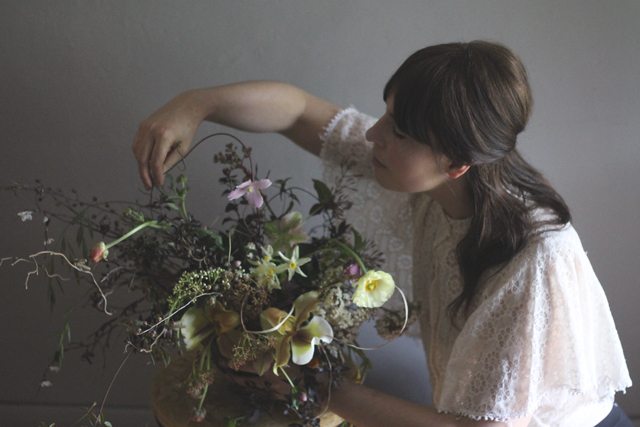
One of the many things I love about the local flower movement is the global network of fellow farmer florists who have connected via social media. I delight in seeing what is in bloom around the world through Instagram photos and posts via The Seasonal Flower Alliance. There are many parallels between the increasing popularity of local, seasonal flowers here in the good ole’ U.S. of A. and what is happening in the U.K., Canada, Russia, New Zealand and far flung corners of the world.
Today, I am thrilled to highlight one of my favorite designers from “down under”– the immensely talented Morgan Allender from Tenth Meadow. Based in Adelaide, the capital of South Australia, Morgan’s floral design business has seen extraordinary success. I’ve been following Tenth Meadow on Instagram for a while now and am always drooling over the dreamy floral designs that Morgan creates and the beautiful way in which she captures them in photos. An accomplished painter and visual artist, Morgan agreed to sit down and chat with me about her work and seasonal flowers.
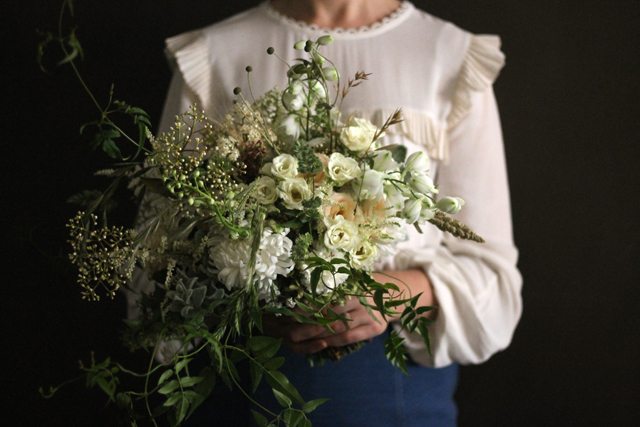
Erin: Thanks for taking time to chat with me today! First, tell me a little bit more about your company, Tenth Meadow. You are doing lots of design work for weddings and events, but you are also growing a lot of your own flowers, am I right?
Morgan: Hi Erin! Yes, like a lot of floral businesses, most of our work involves designing for weddings and events, and some floral details for photoshoots and stylists. We own a small farm about an hour out of the city. It’s a modest 5 acres which is divided into: a 1 acre garden around the house that functions as a traditional cutting garden, two fenced flower growing fields (about a half acre), and then a series of paddocks where our pet cows, Polly and Buttons live. We have plans to gradually add more growing areas each season. The cutting gardens have been established for 5 years and last year we fenced off the two additional fields to increase our plantings. I wouldn’t call myself a farmer florist at this stage, but I am definitely a gardener florist! Right now our aim is to supply our own business with a range of interesting and delicate materials that will supplement what we can buy in from other local growers and the flower markets. I started the business in a borrowed barn 10 mins down the road, then expanded to a large warehouse located right in the middle of the city. Right now we are in the process of moving our whole studio back up to a custom-fitted shed at the farm, so that we can be closer to our own flowers, and so that we can keep an eye on the plants during the growing season. I can’t wait for the luxury of gathering direct from the field, then walking straight into the studio.
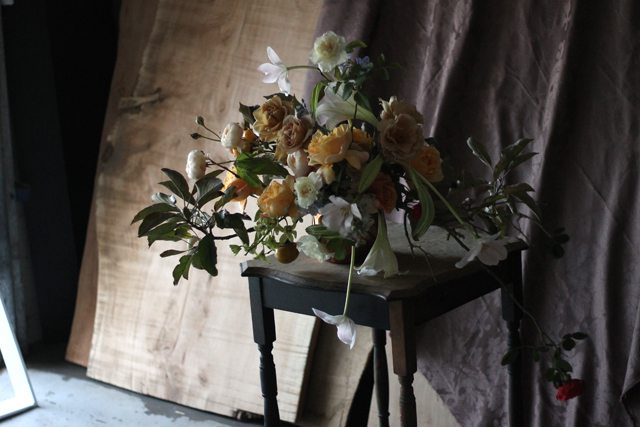
Erin: Your shop in Adelaide in Southern Australia was described by the site Five Thousand as “a room in which to enter a parallel universe where it smells like the forest and feels like a forgotten room just off the city’s most bustling street. It’s a little spot where art and design smell and feel good…” That description makes me want to hop on a plane right now! That shop has since been converted into a studio and meeting space, is that right?
Morgan: We took the shop space on last June because I fell in love with the building; an old stone cottage tucked in quietly among the newer city buildings towering all around it. When we took it on it was wrecked and we spent quite a bit of time fixing it up but this was really part of its crumbling charm. At that stage it was the middle of Winter, business was quieter, but within 4 months our event bookings went through the roof, we became so so busy with that side of things, and to be honest it took us a bit by surprise. It was just the timing- I think our little business had grown up and started to really flourish but it meant I simply didn’t have the time to stand behind the shop counter 4 days a week and if I couldn’t be present in the shop, for me it kind of defeated the purpose of having it, having begun as a kind of personal dream. At that stage I made the decision to close it and use the space to meet with clients, and it’s really great to have a city base where this can happen now that the studio is moving up to the farm.

Erin: I’m really interested in learning what the seasonal flower movement is like in other countries. It seems to be really picking up steam here in the U.S. In just the last two or three years, there has been an explosion of new small flower farms plus more and more designers are seeking out seasonal floral material. Is there strong support for local flowers in Australia? What trends are you seeing?
Morgan: I think the demand for local, seasonal flowers here is growing, although perhaps not yet on the scale that it is in the US or UK. Farmers Markets are really popular here and people are very aware of the benefits of choosing locally sourced foods over imports, and it makes sense that this philosophy should follow through to cut flowers. Flower stands at my local farmers market always sell out, particularly those selling Australian native varieties, and I think people are attracted to the freshness and probably the price-point. My experience is that the majority of people I talk to about flowers still have no idea that so many cut flowers are imported or grown using intensive measures, even those people who wouldn’t dream of eating sprayed vegetables; I don’t think this information is reaching them, it’s not that they don’t care.
Most of my clients are really enthusiastic about the concept of locally grown, pesticide free blooms when offered, and they always comment that they are so much more scented. The challenge in South Australia is climate; in comparison to New Zealand or Seattle or Suffolk it’s very hot and it’s very dry in Summer – growing fragile varieties or growing flowers out in the open in a natural way is not easy and so not always commercially viable for larger operators. Consequently we rely heavily on imports (which have travelled an awfully long way) or those perfect glasshouse blooms, to stock our local flower markets with the variety of flowers that we now all expect. There are some fantastic local growers and wholesalers doing an amazing job, but the variety of unusual bits and pieces is limited without growing your own, or clipping from other people’s gardens. Some florists I know commission local farmers/gardeners to grow particular things for them which is a great idea. There is definitely demand for more local growers of cottage-style flowers and shrubs: small-scale farmers with passion!

Erin: On your blog you recently described the process of photographing flowers so beautifully. I want to repost it here because I think it is so perfect:
“There lies the poetry about working seasonally I suppose, whether it is with food, flowers, gardening, painting, walking…one aspect quietly ends just as the next is unraveling before you. Fleeting moments, flash storms, falling petals. But capturing them in a photo is like taking a little piece of the season and placing it in your pocket, a little souvenir of time and place… for me these photos are also a kind of homage and thank you to all the flowers, now long-faded, that have lent their beauty along the way.”
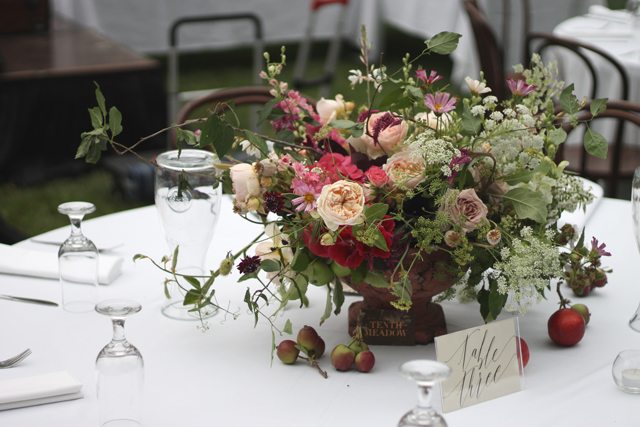
Erin: I absolutely love all your moody photos on Instagram and Flickr. How do you take them? Do you have a background or training in photography? I’m becoming a bit of a photography geek, so I’m curious what camera and lenses you use to capture your beautiful shots.
Morgan: I really love the process of documenting my work, but I’m no professional photographer; it’s something that I would like to be better at. I guess I have a “point and shoot” approach to the photos, rather than a technical one, and have taught myself through trial and error using natural light. It made me giggle when you asked about the camera and lenses I use, I had to go look at the camera because I didn’t know (I now know it’s a Canon EOS 1100D, a very basic model I am told). You can see that I’m not very tech-minded…It was the same with Instagram; I resisted joining for so long because I’m not entirely comfortable with some aspects of social media I guess. Lucy, my floral assistant, showed me how to use it and now I love its potential as another way of making beautiful images. Sometimes I think that I enjoy the process of recording the flowers even more than the actual arranging of them.
My background is in Visual Art – I majored in painting and then taught painting for a few years at one of the art colleges here. I think when I am making floral arrangements, and framing up photos I am approaching it in a similar way that I would make a painting; it’s still a combination of colour, shape and texture brought together to evoke a certain mood. Photographing flowers was actually the way that I first got started in floral design. I was putting together source material for my paintings, gathering flowers and leaves and taking pictures of them that I would them translate into painted image. Friends started making requests, followed by a few small weddings, and then the business grew from there. I still use this method when planning my paintings, and it’s now interesting that the flowers inform the paintings and visa-versa. I see them as two complementary halves of the one studio practice.
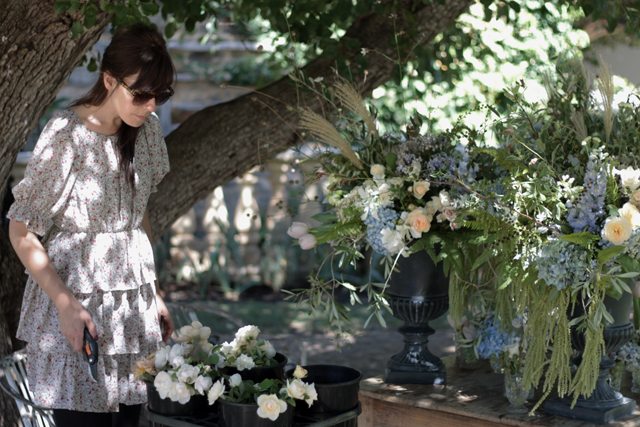
Erin: You recently blogged that, “Winter is a good season for thinking, while Summer is all about doing.” What were some of the highlights of the most recent growing and wedding season?
Morgan: Last season saw the properly fenced growing areas go in (we get rabbits, hares and kangaroos nibbling on plants), and that was an exciting move forward for me. I am lucky in that my dad runs a large wholesale nursery and last year he put thousands of seeds through his machines and germinated them in his greenhouses for us, increasing the success rate overall. The plants arrived in a truck in 1-inch cells, ready to plant out. Having them all arrive at once like that was definitely a highlight! A lot of the climbing and rambling roses we have planted in recent years reached a size where we could hack large bits off them and they lend such a beautiful wildness to large urn arrangements.
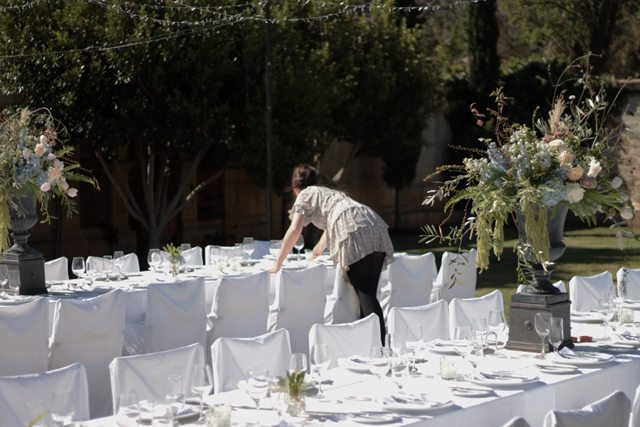
Morgan: Wedding-wise, the best thing for me was probably that the majority of clients just let me run with the designs, rather than prescribing specific details. It seems like such a simple thing, but it has taken time to get to this point, build up that trust, and I think lots of other florists will relate. With so much bridal inspiration online, it is easy for brides to plan everything right down to the tiniest detail and arrive at an initial consultation with an ipad full of borrowed images for the florist to recreate. I find it difficult and disheartening trying to emulate exactly what someone has dragged off a wedding blog, and now I won’t do it at all. It feels exciting and meaningful to be allowed to just get on with it and create something beautiful for a wedding, and us florists know that this freedom allows us to use the best of what the season has to offer. The magic is often in the unplanned, and bouquets always turn out better this way of course.
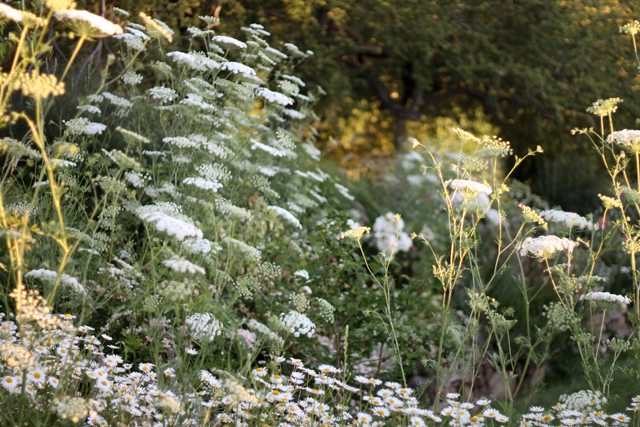
Erin: What varieties of flowers are you thinking and dreaming about growing for next summer?
Morgan: My favourite flowers to grow are probably the umbellifers: Queen Anne’s Lace, yarrow, orlaya, etc, so floaty and delicate. Last season I grew these in random swathes among other plants because I like the romantic effect, but this year they are going in direct-sown rows for easier harvesting. I have to be sensible about what I choose to plant in terms of climate suitability, it just doesn’t make sense to plant things that need loads of water poured onto them to survive, especially as we rely on water tanks and a bore with no council water supply. Our soil is a heavy clay that is lovely and rich but sets like concrete by Summer (we are adding in more and more organic matter each year). After trialling all sorts of things, we’ve now decided to concentrate on hardy perennials, shrubs and climbers (especially roses), and a smaller selection of annuals and biennials. This is mainly to satisfy our need for all the wilder bendy scruffy leafy bits which give arrangements that special something. Hellebores grow really well here, yay!- they have remarkable drought-resistance once established. I am currently really enthusiastic about penstemons, and we’re planting lots as a kind of hot weather alternative to foxgloves.
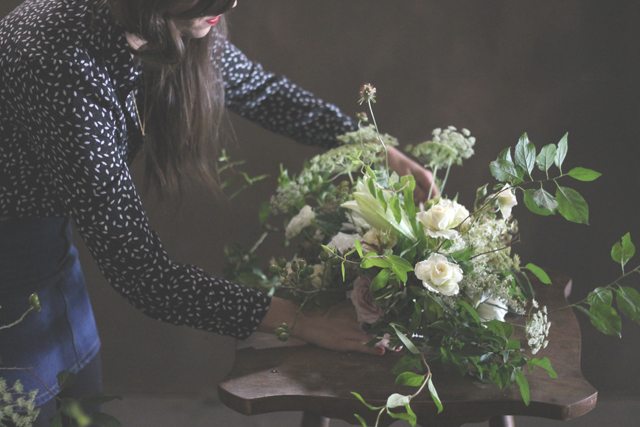
Erin: You wrote that you like flowers that don’t “clamor for attention, those that when you carefully hold them and turn them upwards toward your face, their beauty is revealed, and is breathtaking.” What are a few of your favorite varieties of these types of flowers? (I won’t dare ask you to pick just one. As a fellow flower fanatic, I can never pick just one!)
Morgan: Aquilegia, foxgloves (especially the leathery witchy-looking ones), clematis. Flowering shrubs such as abelia, weigela, philadelphus and viburnum. Forget-me-nots! We have these lovely native Australia plants called correa (do you have them there?) which have delicate little bell flowers and rough little leaves with a fuzzy coating, and I adore all the various types for foliage and flowers. Cowslips make me go a bit silly and I quite like wild briar roses, the ones that smell like apples when you crush the leaves. “Black Velvet” nasturtiums.
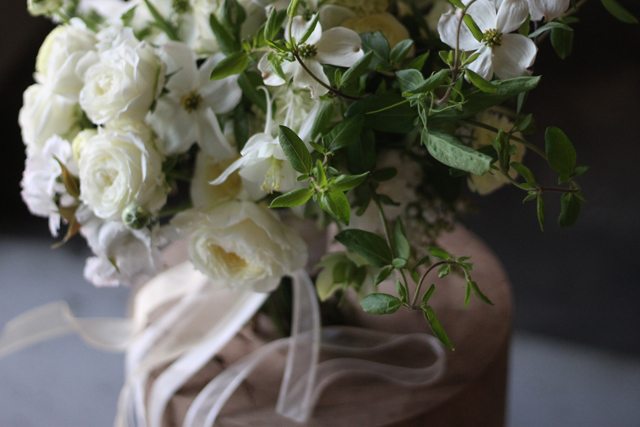
Erin: What are some of the most popular wedding flower trends you’re seeing in Australia?
Morgan: At the moment everyone wants hanging floral installations and flower walls, probably more than half my clients this year have requested this in an initial meeting. From listening to people talk about how much they love the idea of suspended floral details I’ve noticed a pattern emerging in what they say; they want a lushness and a leafiness to lend a magical quality, and often they admit that an outdoor garden or forest wedding would be amazing but not possible for various reasons. I find this fascinating, and think about it a lot – my theory is that the trend for hanging florals is representative of something deeper: part of a widespread craving for a (re)connection with the natural world that we are seeing across different design and lifestyle streams (beekeeping, vege plots, natural fibres, houseplants, handcrafts, etc etc). People want to emulate the feeling of being immersed in nature, to feel the romantic childlike wonder of stepping under flowering branches and looking up into the faces of flowers, to be enveloped. It’s an emotionally-driven request I think, that goes beyond wanting something big or impressive.
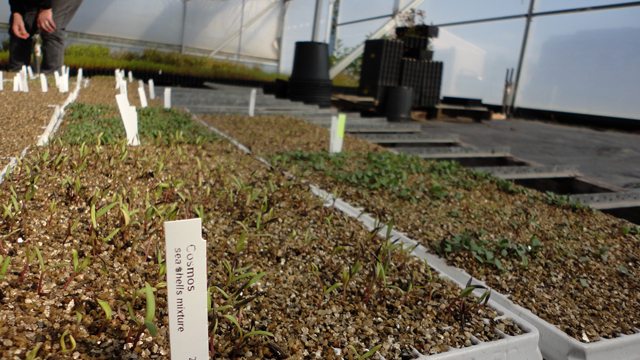
Erin: Last year you blogged that you were in love with wrist corsages again. Is that still the case? You said, “on grandmothers especially, they seem fitting, and nostalgic; carrying memories of dances and country halls, homemade dresses, and sweethearts walking home on summer evenings” Your words conjure so many beautiful images made me want to fall in love with corsages too! What floral materials do you like to use when making them? Do you use the standard elastic bands, ribbon ties or those slap bands? Any tips or tricks to making them you’d care to share?
Morgan: Ha, I did say that didn’t I!? I think when I wrote that I was high on a really lovely wedding I had just done, with wrist corsages. Truth be told, I have a love/hate relationship with corsages : I do mean what I wrote, but at 5am on a wedding day they can also make me tear my hair out. Lucy has a sweet, patient disposition that is well suited to making these smaller fiddly details and this season it will be mainly her department. (I like to focus on bouquets and the big messy elements!). I favour a wilder foliage-based approach to corsages and buttonholes, with the flowers woven in. We generally build them to last! The only complaint that I have ever received was from a bride whose buttonholes wilted under the hot Summer sun; I mean it was literally 44C (110F) in the shade on that day and the flowers were doing their best I am sure! So now I am very careful to choose materials that are weather appropriate. I have tried all the methods of attaching them to the wrist and now I often ask the client what they would prefer: mums and grandmas often go for the slapband (we use a pale grey understated band), but I like the look of ribbon on bridesmaids. The beaded, bedazzled elastic bands are a bit glitzy for my taste, but each to their own…
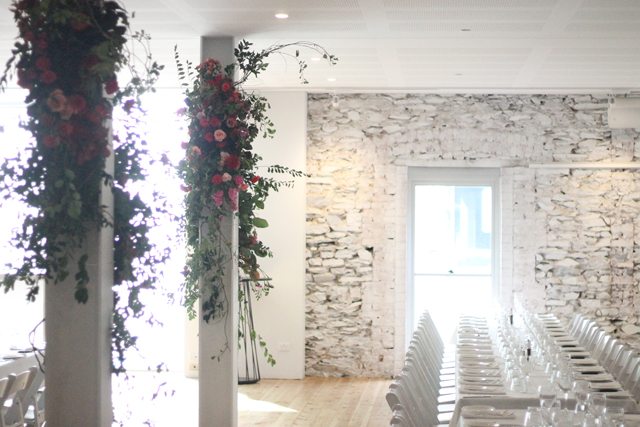
Erin: What is the most memorable floral installation you’ve created?
Morgan: It’s difficult to choose, but the first one that comes to mind was a wedding we did last Autumn. It was quite small and intimate in a beautiful room above street level. It was one of those wonderful weddings where we had complete creative freedom apart from a request for no table flowers. The room was all white – walls, tables, chairs, everything- with the most beautiful stonework also painted white. Against this minimal backdrop, we enveloped two architectural pillars in trailing vines and leaves studded with flowers, with branches arching up towards the ceiling in a romantic tangle. It was one of those jobs that just felt natural, the planets aligned and it was smooth and easy, and for the kindest family. It was interesting for me to see such billowing wildness against a really stark background and, being such a lover of old-world styling, something I wouldn’t normally do; it was almost like placing the flowers into the white box of an art gallery and I loved seeing them in that context.
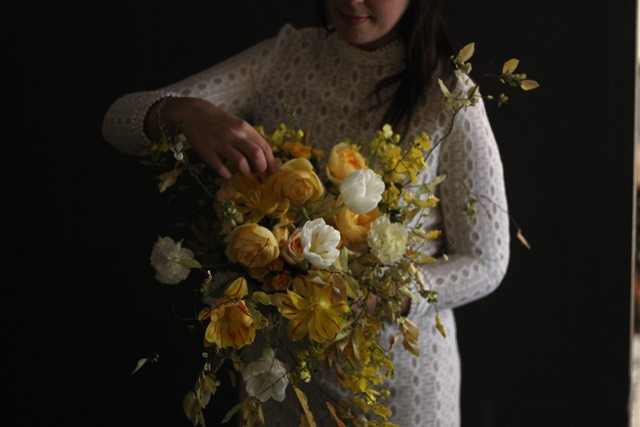
Erin: Finally, tell me about the name Tenth Meadow. I sense it may be symbolic or have a great story behind it. What can you share?
Morgan: When I started, I called myself The Bluebell Society and within a short time the cuteness of that name became irritating, even though I had chosen it myself. At the time that I was searching for a new name, I was reading Adam Nicolson’s “The Smell of Summer Grass”. I love him, he writes so beautifully and with feeling. In the endpapers of the hardcover edition is a lovely hand-drawn map of his farm at Perch Hill with the individual names of each field carefully noted; they have names like “Great Flemings” and I thought there was something really intriguing about these ancient names that have been passed down through the generations of land ownership. I guess I wanted to capture that feeling in some way, or subtly refer to it. The name is also literal – our farm is divided into ten separate areas or paddocks, which is where the number came from, and the largest flower field is number 10!
Erin: Thank you so much for chatting with me today and for sharing so many amazing images of your designs and your lovely, lovely home. I really appreciate the opportunity to learn more about your fantastic work and the local flower movement in Australia. Wishing you a great growing season!
Morgan: Oh, thank you Erin, for your beautiful blog, and your generosity and passion, it reaches us all. The world is truly a better place because you are in it.
You can find Morgan and the Tenth Meadow on the web here:
Website: https://www.morganallender.com/
Instagram: https://www.instagram.com/morgan.allender

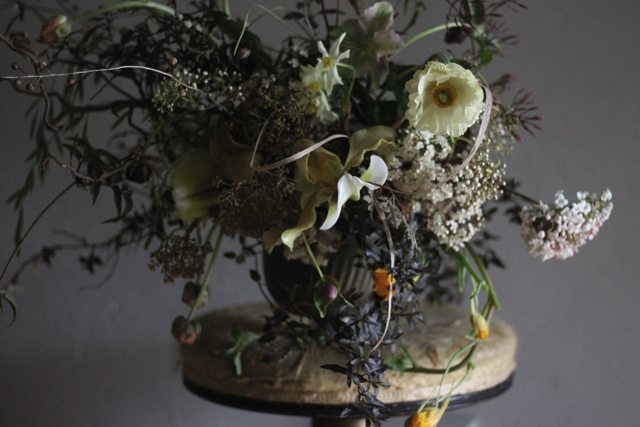
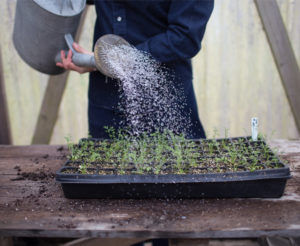
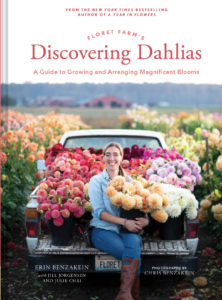
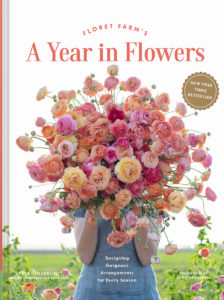
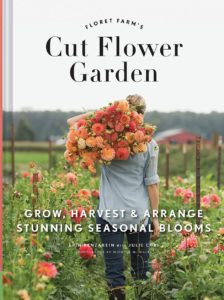

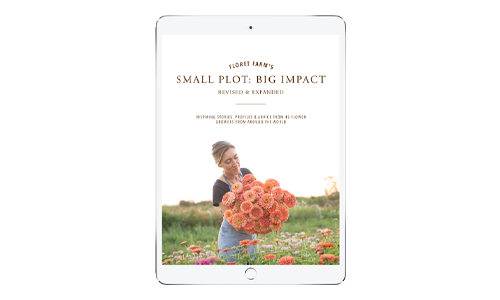
Anne Matthews on
Wonderful style!